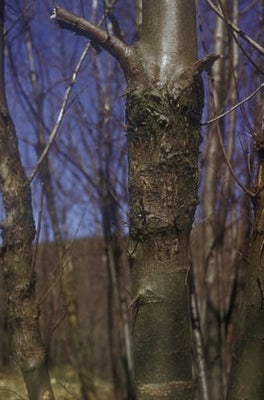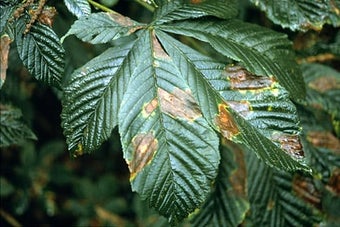
Quick facts
Common name - chestnut blight
Scientific names - Cryphonectria parasitica
Plants affected - mainly Castanea sativa and C. dentata. Also trees in the Fagaceae family including Quercus spp and Acer spp
Main symptoms - cankers, wilting and dieback of the stems
Timing - Bright orange pustules produced throughout the year following wet weather during mild conditions
What is chestnut blight?
Chestnut blight is a fungal disease caused by Cryphonectria parasitica. In the UK the disease poses a significant threat to about 12,000 hectares of woodland which has sweet chestnut (Castanea sativa) as the dominant tree species, most of which is located in southern England.
Chestnut blight has caused devastating losses in North America, where American chestnut (Castanea dentata) was eradicated from eastern North America in the first half of the 20th century because of the disease. The fungus was originally introduced from eastern Asia. Chestnut blight has also spread throughout continental Europe since it was first discovered in Italy in 1938.
Horse chestnut or ‘conker tree’ (Aesculus hippocastanum) is unrelated to Castanea and is not affected.
Symptoms
Some typical symptoms:
- On leaves: The foliage wilts and dies as a result of girdling cankers lower down the stem
- On stems: Striking contrast between green healthy and diseased orange on young stems. Underneath the bark buff-coloured fungal growth may be seen. Cankers (swollen or sunken) develop on the stems on which masses of yellow-orange to reddish-brown pustules (fruiting bodies), the size of a pin-head, are visible. The tree sprouts new shoots below the cankers, and these shoots can also subsequently become affected
- On the whole tree: Cankers spread throughout the tree surface, killing the tree. Although young trees may succumb to the disease within a year, it may take years before mature trees eventually die. The root system is not affected
More photos of the symptoms, together with details of the current situation with regard to outbreaks, can be found in the Forestry Commission profile on the disease.
Control
Non-chemical control
If you suspect that chestnut blight is present in your garden you should not attempt to control the disease yourself. You should report your suspicions immediately to the relevant plant health authority, whose contact details can be found on the UK Plant Health Information Portal.
Chemical control
There is no chemical control available to gardeners for this disease.
Biology
Cryphonectria parasitica overwinters in lesions and colonized . The spores are produced in wet weather and at any time of the year pending mild temperatures. The spores are dispersed via wind, rain or vectors such as insects and birds. Infection is initiated when spores land on freshly wounded bark. The susceptibility of the host tissues decreases after a few days. The fungus kills the bark and cambium by a combination of mechanical and chemical actions. It is also reported that the pathogen can exist as a saprobe (i.e. it lives and feeds on dead organic matter) for at least two years on moribund bark. Long distance spread is by movement of infected plants, wood or bark. Risk of transmission by fruits or seeds is small.
There is also evidence that the pathogen can weaken in virulence in Europe and some American localities due to infection of the fungus by a virus (dsRNA hypovirus CHV1). The virus limits the ability of the pathogen to produce spores, reduces its growth and its ability to produce enzymes that kill the host tissues. This phenomenon, known as hypovirulence, allows the trees to recover. The discovery of hypovirulent strains of the fungus raised hopes for biological control of the disease. However the success has been limited because the virus does not spread readily between strains and hypovirulent strains do not compete very well with virus-free fungal strains. Scientists are working towards manipulating hypovirulence to develop it as an efficient method of biological control.







